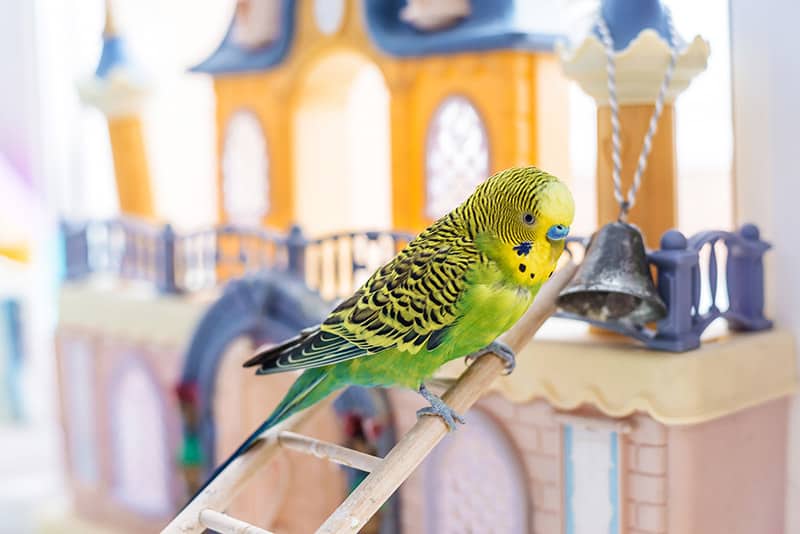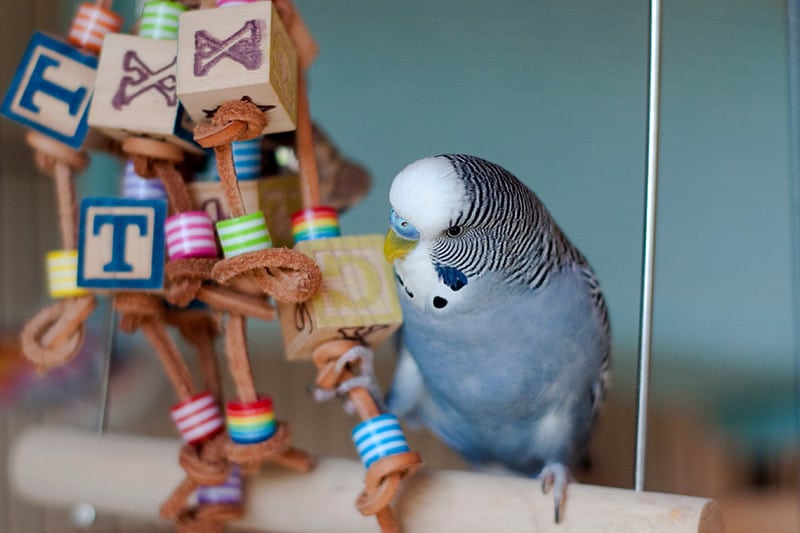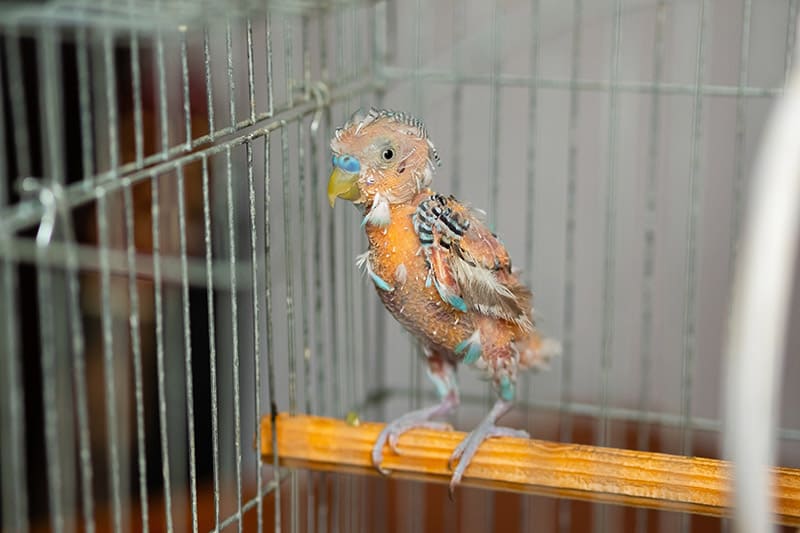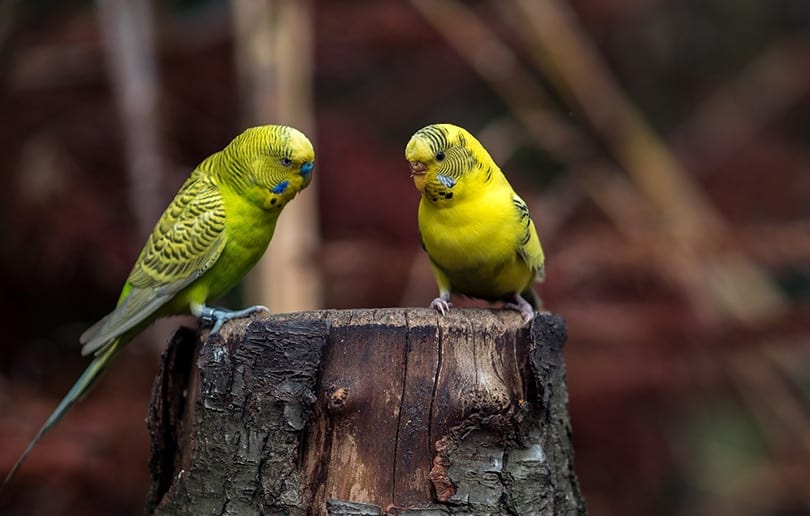Colorful, attractive, and lively are just some of the great attributes of the Parakeet or Budgerigar. With their warm and inquisitive personalities, they make a great pet for both the beginner or an experienced bird keeper. They are quite hardy, inexpensive, and easy to care for.
- To learn more about Parakeets and their needs visit: Guide to a Happy, Healthy Parakeet
Scientific Classification
| Kingdom: | Animalia |
| Phylum: | Chordata |
| Class: | Aves |
| Order: | Psittaciformes |
| Family: | Psittacidae |
| Genus: | Melopsittacus |
| Species: | undulatus |
Scientific Name
Overview, history, and species variants
The parakeet, or Budgerigar, belongs to the family of true parrots, which explains why the parakeet is relatively adept at learning to talk. The parakeet comes from Australia and the first European to write anything about these colorful birds was John Gould in 1865 in his work titled “Birds of Australia”.
This bird, along with about 30 – 45 other small broad-tailed parrot species, belong to a tribe called Platycercini. The members of this group are all native to Australia in particular, but also to Australasia, New Zealand, New Caledonia, and nearby islands. Besides the Budgerigar, It includes birds like the grass parrots, Rosellas, and the New Zealand parrots.
In the wild, the Parakeet or Budgerigar, comes from the interior of Australia where the landscape is almost desert-like and there are no regular rainy seasons. This arid environment will go for months and sometimes years without rain. Needless to say, this is a hardy bird.

Pet appeal
Parakeets make very good pets as long as they have a lot of attention and love. These birds are very social by nature. Living in groups of 20 to 40 and sometimes as many as 60 birds in the wild, and don’t like to be left alone. So if you own only one bird and you work 8 hour days, think about possibly getting him a mate or finding someone to at least keep the bird company for part of the time that you are gone. Parakeets make just as good of pets singly or in pairs or more, but make sure that you introduce one bird at a time.
Parakeets are monogamous so once they find a mate it is usually for life unless of course one of them has an untimely death in which the other would then find a new mate. Parakeets are very good flyers. In the wild they fly back and forth across vast regions searching for food and water, so provide them with free flying time and you will have a much happier birds.
Description
Parakeets come in over 100 color forms but primarily in green (typical in the wild), various shades of blue, opaline, gray, white, yellow (lutino), pied (combination in one bird), and in various shades of these colors, some rarer than others.
Parakeets are 7″ to 9 3/8″ in length from the tip of the bill over the head to the tip of the tail. The tail by itself is 3 1/8″ to 4 1/2″ long. Parakeets weigh anywhere from 1 – 1.4 ounces ( 30-40g). The life expectancy of the average parakeet is 12 to 14 years. They reach sexual maturity at 3 to 4 months. By this time they have their adult plumage which is quite unusual in the bird kingdom.
Care and feeding
Ready-made staple seed mixes are usually available at your local pet store or supermarket which contains a mixture of canary grass seed, white millet, yellow millet, oats and groats and red millet, niger seed, and linseed. Some higher-quality seed mixtures come with thistle, anise, rape, sesame, and safflower seed. Vitamin pellets with iodine in them are sometimes present to prevent thyroid problems. Store the seed in a dark but airy place. Not in plastic bags but in a clothes bag in a closet. Offer fresh foods such as eggplant, green peas, cucumber, young dandelion greens, sweet corn, beet greens, carrots, unsprayed lettuce, green peppers, sorrel, spinach leaves, tomatoes and zucchini. Fruits that are suitable are Pineapples, apples, apricots, bananas, most other fruits.
Food that is bad for birds includes All members of the cabbage family, raw and green potatoes, green beans, grapefruit, rhubarb, plums, lemons, and avocado.
Parakeets also need a mineral block and a cuttlebone in their cage. These provide all the minerals and trace elements that they need. Offer spray millet every so often as a treat. And of course fresh water daily.
Housing
Provide a roomy cage with the minimum dimensions of: 20″ long x 12″ deep x 18″ high. The ideal size is: 40″ long x 20″ deep x 32″ high. Preferably a cage with horizontal bars to make climbing easier. You can also attach a perch/play area on top of the cage. In the cage have about three perches of different diameters (or branches with some angling) without the sandpaper guards. A swing and mirror among other toys are available but be sure to leave enough room for flying! Food and water dishes, preferably automatic dispensing, or if not, ones with guards to prevent waste contamination. Clips to hold spray millet and fresh food. A bathhouse with a textured bottom is a favorite, or a slow-running faucet will do. Provide a breeding box if breeding is what you have in mind.

Maintenance
The basic cage care includes daily cleaning of the water and food dishes. Weekly you should wash all the perches and dirty toys, and the floor should be washed about every other week. A total hosing down and disinfecting of an aviary should be done yearly, replacing anything that needs to be freshened, such as old dishes, toys and perches.
Handling and training
Take it slow at first and let the parakeet get used to you and its new surroundings before trying to get him to go onto your finger. Allow flying time and don’t worry about catching him to put him back into the cage, leave the cage door open and sooner or later he will get hungry. After a while curiosity will overcome fear and training can begin.
Most but not all parakeets have the inclination to talk, be repetitive and patient.
Activities
Free flying time is very important. Try to offer several hours a day in a bird-safe room. A bird tree ( this can be made by wiring branches together into a tree or surrounding a tall house plant with perches, not poisonous of course), is very useful. Set it across the room from the cage, so that they fly back and forth. This will provide them with ample exercise.
Breeding
The male parakeet’s cere is blue and the females is tan or light yellow. The “cere” is the area located at the base of the beak, just below the forehead or crown area. It is where the two nostril-type openings (nares) are also located. There are a few exceptions, but for the most part this coloration is fairly accurate. In young parakeets, under 3 months, it is pale pink to tanish but changes after sexual maturity.
If a pair of parakeets are ready to mate they will court one another first by playing and then feeding each other. The male then attempts a balancing act on the females back and lowers his tail under hers till the vents connect.
The female picks the nesting sight and lays her eggs, one or two every other day, for a total of 4 to 6 eggs in a clutch. Incubation is 18 days but the hen will remain on the nest till the chicks start to get feathers. Separate the nesting hen from the other parakeets. Nesting material is not necessary till after the chicks hatch then you can cover the bottom of the box with pine shavings, never saw dust. Be sure that the hen is feeding the young and if not, hand rearing may be necessary.

Potential Problems
The most common would be a parakeet plucking out its own feathers. This is usually caused from loneliness and boredom. Another problem is if the leg band is too tight then a veterinarian will have to remove it. If taken care of, the parakeet is a hardy pet well worth the money and effort!
Availability
Budgies are readily available and inexpensive.
Featured Image Credit: bildgebende_Momente, Pixabay
